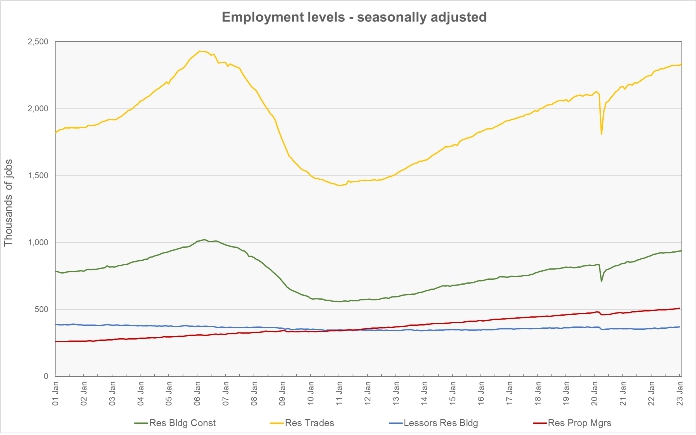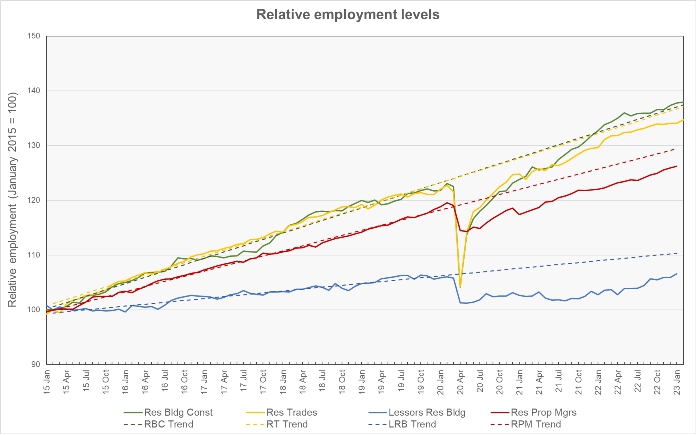The Employment Situation Report from the Bureau of Labor Statistics stated that both residential construction employment and apartment operations employment rose in the latest month.
Job growth continues
The Bureau of Labor Statistics (BLS) reported that employment increased by 311,000 jobs in February, based on their survey of business establishments. This compares to employment gains of 517,000 jobs in January and 260,000 jobs in December.
The BLS household survey reported that the US unemployment rate rose to 3.6 percent, up from 3.4 percent last month and 3.5 percent in December. The household survey found that the number of employed persons rose by 177,000 from that reported last month while the number of unemployed persons rose by 242,000.
The household survey found that the number of people in the civilian labor force rose by 419,000 in February while the adult population rose by 150,000. These changes caused the labor force participation rate to tick up 0.1 percentage point to 62.5 percent. It had been at 63.4 percent before the pandemic. Recovering that 0.9 percent decline in the labor force participation rate would bring 2.4 million more people into the workforce.
Multifamily employment higher
The BLS reported more detailed employment information on four job categories of interest to the multifamily industry. These are employment as residential construction workers, as specialty trades within residential construction, as residential property managers and as lessors of residential buildings. As usual, some of the data is reported with a month delay, so the latest figures for the latter two categories are for the month of January.
The first chart shows the long-term history of the levels of employment in these four jobs categories.

Residential construction employment moves higher
Employment in residential building construction in February, usually with general contractors, was reported to be up 1,200 jobs from the revised (+3,200) level of the month before. Employment in this category is now 938,500 jobs, up 3.1 percent year-over-year and 12.1 percent higher than its level in February 2020.
Employment in residential building trades, i.e. plumbers, electricians, etc., in February was reported to be up 11,200 jobs from January’s revised (-5,900) figure at 2,336,500 jobs. Employment in this category is up 2.7 percent year-over-year and is now 9.8 percent above its level in February 2020.
Total February employment in these two categories of residential construction jobs combined was up 0.4 percent from the revised level of the month before. Residential construction employment was 10.4 percent above its level in February 2020.
Apartment operations jobs also rise
Employment for residential property managers in January was reported to be up by 1,300 jobs (0.3 percent) from its revised (-500) level for November to 508,000 jobs. Employment for residential property managers is up 3.4 percent year-over-year and is up from its February 2020 level by 5.6 percent.
Employment for lessors of residential buildings was reported to rise in January by 2,500 jobs from December’s revised (+400) level to 369,800 jobs. Employment in this category is up 3.7 percent year-over-year and is now 0.5 percent above its pre-pandemic level.
Total employment in these two categories combined was reported to be up 0.4 percent from the level reported for last month. It is now 3.8 percent above its level in February 2020.
A closer look at trends
The final chart, below, presents the employment data in a different format. It normalizes the employment levels in all four jobs categories to a reading of 100 for January 2015. It also provides trend lines for the growth in each of the categories of employment based on the period from January 2015 through February 2020.

The chart shows that residential building construction is the only one of the four jobs categories that we track whose employment level is now above the trend line. It is 0.4 percent above trend. Residential trades employment is now 1.7 percent below trend, residential property managers employment is 2.5 percent below trend and lessors of residential buildings employment is 3.4 percent below trend.
Given the slowdown in residential construction that has accompanied the recent rise in interest rates, it is perhaps surprising that construction employment is holding up so well. However, while housing starts are down year-over-year, the total number of units under construction is not, and this may be supporting construction employment.
The growth in employment for the two classes of apartment operations jobs is below the trend line. At least in the case of residential property managers, the employment growth does not seem to be approaching the trend, which may indicate that apartment operators are planning to permanently get by with fewer people.
The numbers given in the Employment Situation report are seasonally adjusted and are subject to revision. It is common for small adjustments to be made in subsequent reports, particularly to the data for the most recent month. The current Employment Situation report can be found here.















